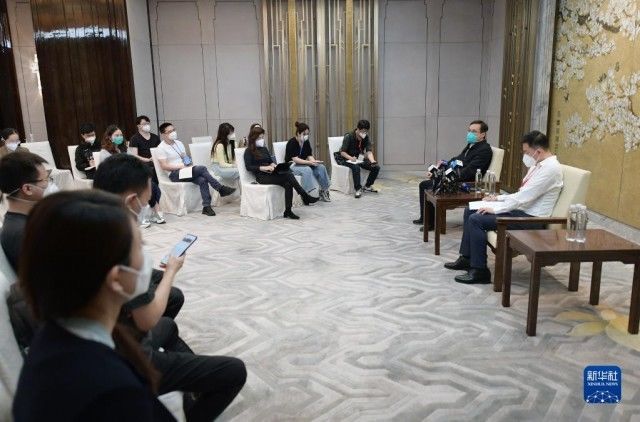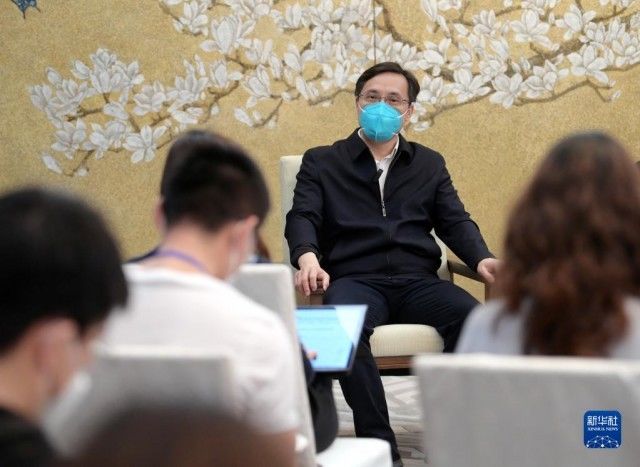
Huang Luqi, deputy director of the State Administration of Traditional Chinese Medicine and academician of the Chinese Academy of Engineering, was interviewed by reporters in Shanghai (photo taken on April 25). Photo by Xinhua News Agency reporter Li He
Xinhua News Agency, Shanghai, April 26, “In order to fully support Shanghai’s anti-epidemic work, under the deployment of the State Council’s joint prevention and control mechanism, and under the organization and coordination of the State Administration of Traditional Chinese Medicine, TCM medical institutions from 20 provinces sent a total of 9,285 Among them, 4 medical teams are taking over the makeshift hospitals.” Huang Luqi, deputy director of the State Administration of Traditional Chinese Medicine and academician of the Chinese Academy of Engineering, said in an interview with reporters in Shanghai recently.
According to Huang Luqi, Shanghai TCM medical institutions have dispatched more than 2,000 medical staff, who have successively participated in the management of 28 makeshift hospitals or some wards.
In designated hospitals and Fangcang shelter hospitals, in addition to Chinese herbal decoctions and proprietary Chinese medicines, the TCM medical team also uses non-drug therapies such as acupuncture, ear acupuncture, and massage, as well as online courses in TCM in Fangcang shelter hospitals.

Huang Luqi, deputy director of the State Administration of Traditional Chinese Medicine and academician of the Chinese Academy of Engineering, was interviewed by reporters in Shanghai (photo taken on April 25). Photo by Xinhua News Agency reporter Li He
Huang Luqi said that in this round of Shanghai epidemic, Chinese medicine has participated in an all-round and in-depth way, and has played an important role in “prevention, treatment and health” in prevention and treatment, mainly in two aspects: first, classification and stratification, promoting the prevention of traditional Chinese medicine The second is to strengthen the advantages and characteristics of traditional Chinese medicine resource allocation and treatment process.
Among the currently hospitalized patients, 30% are over 60 years old, and 60% have underlying diseases. How to not only reflect the cooperation of traditional Chinese medicine and Western medicine, but also reflect the co-treatment of new coronary pneumonia and underlying diseases in the treatment of the elderly is a big challenge.
“Under the guidance of experts from the Shanghai Working Group of the Joint Prevention and Control Mechanism of the State Council and the support of experts from all over the country, the Shanghai Administration of Traditional Chinese Medicine has established national and municipal expert groups to conduct consultations and inspections, and formulated corresponding Chinese Consensus on medical treatment, regular case studies, and daily statistics on the treatment of elderly and critically ill patients with traditional Chinese medicine.” Huang Luqi said.

Huang Luqi, deputy director of the State Administration of Traditional Chinese Medicine and academician of the Chinese Academy of Engineering, was interviewed by reporters in Shanghai (photo taken on April 25). Photo by Xinhua News Agency reporter Li He
Huang Luqi said that in the follow-up epidemic prevention and control work, the first is to continuously improve the coordination of Chinese and Western medicine in designated hospitals and Fangcang shelter hospitals according to the admission and treatment of patients in Shanghai; rate, etc., focus on clinical observation and clinical program optimization, and further explain the advantages and characteristics of traditional Chinese medicine.
According to reports, multiple departments in Shanghai have jointly formulated a Chinese medicine security supply plan, providing Chinese medicine security to designated hospitals, makeshift hospitals, and key groups. (Reporters Gong Wen, Li Shuzhen, Li Hengyi, Li He)